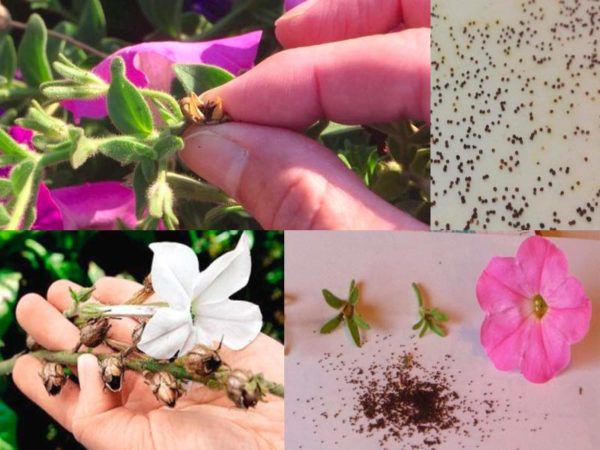How to properly collect petunia seeds at home
Petunia is prized for its fast growth, beautiful, abundant and long flowering. An incomparable joy for the gardener is to grow a flower from a seed. Watching how a seedling appears from a seed, which then turns into a beautiful, flowering plant, causes a lot of emotions and pride in the work done. And for this, first of all, you need to stock up on high-quality planting material. Let's take a look at how to harvest petunia seeds, when to do it, and how best to store them.
The content of the article
Is it possible to independently collect petunia seeds

Petunia is a flowering herbaceous or semi-shrub plant with a variety of varieties and types. Gardeners usually breed it as a one-year-old, decorating balconies, flower beds, front gardens.
Reference. From any variety of petunia, except terry and ampelous, you can collect the seeds yourself.
The best option for collecting material is simple monochrome varieties, since the new plants will completely repeat all the characteristics of the mother: from the color and shape of the flower to the characteristics of the bush itself. White, pink, purple, lilac colors are well inherited, but red and yellow can slightly change the shade.
You can also harvest seeds from hybrid petunias. Only the seedlings will differ significantly from the parent plants. Seedlings of hybrid types rarely repeat the flower shape and color - only in 30-40% of cases.
How to properly collect petunia seeds at home

The principle of collecting petunia seeds is the same for all varieties and varieties and comes down to several stages:
- Choosing a mother plant.
- Compliance with the maturation of the seed bolls.
- Direct collection of planting material.
- Correct preparation of grains in the form of drying and ripening.
The exception is ampel and terry varieties. Ampel varieties are extremely capricious and whimsical, therefore they are bred in a vegetative way.
Terry petunias do not form seed material, they are not adapted to this. In them, the ovary is converted into additional petals, and this is how terry is achieved. In this regard, their breeding is carried out exclusively in a vegetative way.
When to collect
Seeds ripen after 3 months from the beginning of active and abundant flowering. Favorable time for collecting planting material is August and September.
Reference. It is better to collect in dry, sunny and calm weather.
The fact that the seeds are ripe will be indicated by the color of the box in which they are located. It will dry out and turn yellow or light brown. It is important not to miss the moment here, otherwise the box will open and all the contents will scatter.
Where are the seeds
To find out where the seeds of the petunia are, you should wait until the end of flowering. A box appears in place of a wilted flower. It is bivalve, oval, slightly pointed in shape. At first it is green, and as it matures, it becomes light brown, yellowish, dry and reaches a size of 10 × 8 mm.
The capsule is filled with very small seeds. Their size does not exceed 0.6 mm, and their weight is 0.05 g (smaller than poppy seeds). The color is dark brown or black. There are about 100 seeds in a box.
Collection and preparation of seeds

Collecting petunia seeds at home is a painstaking and lengthy process:
- Carefully remove the wilted and dried flower without damaging the peduncle, sepals and receptacle. Better to take flowers that are at the bottom of the stem. There the seeds are tied and ripen faster.
- A box will appear under the flower, at first small and green. As it matures (about 3 weeks), it will slightly increase in size, dry out and turn light brown in color.
- Cut the ripe box together with the sepals, bring it into the house and place it on white paper or napkin.
- Open the capsule and sprinkle the seeds on a white surface so that the black seeds are clearly visible.
The collected material must be dried for 2-3 days in a dry place at room temperature without exposure to sunlight. Then you can send it to storage for ripening.
Seed storage
The collected and prepared seeds are poured into paper bags or envelopes, each of which is signed, indicating the name of the variety, color, and other characteristics of a particular plant.
Store seeds at room temperature in a dry and dark place. It is better to place it away from heating devices, otherwise it will negatively affect germination.
Reference. Planting material is stored for up to 4 years without loss of properties and germination.
Sowing petunia seeds for seedlings is carried out in early February and March. Due to the observance of such terms, the plant will delight with flowering in May - early June.
Conclusion
Petunia is a popular summer plant, loved by flower growers for its unpretentiousness, fast growth, beautiful and lush flowering. Often gardeners want to keep their favorite variety, so many resort to self-collection of seeds and growing seedlings.
For collecting seeds, simple, monochromatic varieties of petunias are best suited, since in this case all the characteristics of the plant are well transmitted. It is also possible to take seed from hybrids, but the seedlings will not retain the decorative properties of the mother plant. Ampel and terry petunias are bred only vegetatively.